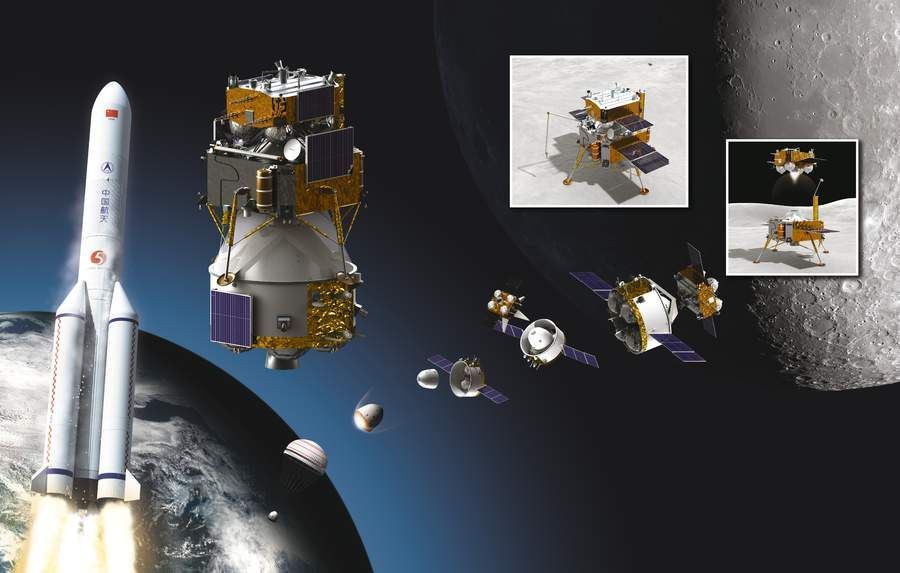China’s Chang’e 5 Mission to Collect First Moon Samples Since 1976
Article by Mike Wall November 23, 2020 (space.com)
• On November 23rd, China’s robotic Chang’e 5 mission launched to land on the Moon and retrieve lunar rocks, and bring them back to Earth in mid-December. The last time Moon rocks were brought back to Earth was the Soviet Union’s Luna 24 mission in 1976. Chinese officials have been characteristically vague about the details.
• The Chang’e 5’s will arrive in lunar orbit around November 28th, then send two of its four modules — a lander and an ascent vehicle — to the lunar surface a day or so later. The landing target is the Mons Rumker area of the Oceanus Procellarum (“Ocean of Storms”) volcanic plain. This area has been extensively explored by a number of other missions, including NASA’s Apollo 12 in 1969.
• Over the course of two weeks, the stationary lander will use cameras, ground-penetrating radar, and a spectrometer to study the area. It will collect about 4.4 lbs of lunar material, some of which will be dug from up to 6.5 feet underground. The timeline is tight given that it needs to accomplish its objectives before the sun light turns to shadow in two weeks, as the lander is solar powered.
• The rocks at Mons Rumker were formed 1.2 billion years ago. The 842 lbs of Moon rocks brought home by the Apollo astronauts between 1969 and 1972 are considerably older, providing a window in the deeper lunar past. Chang’e 5 “will help scientists understand what was happening in the more recent past of the Moon’s history.
• The Chang’e 5 lander will transfer its rock samples to the ascent vehicle, which will launch them to lunar orbit for a meetup with the other two mission elements, a service module and an attached Earth-return capsule. Loaded into the return capsule, the rocks will be brought back to Earth by December 16th or 17th. Rather than relying on strong heat shielding to blast through the atmosphere on re-entry, as the Apollo capsules did, Chang’e 5 will perform a ‘skip reentry,’ bouncing off the atmosphere once to slow down before plummeting to a landing in Inner Mongolia.
• Chang’e 5 is the sixth mission in the Chang’e program of robotic lunar exploration, which is named after a moon goddess in Chinese mythology. China launched the Chang’e 1 and Chang’e 2 orbiters in 2007 and 2010, respectively, and the Chang’e 3 lander-rover duo touched down on the Moon’s near side in December 2013. The Chang’e 5T1 mission launched a prototype return capsule traveling around the Moon in October 2014, to help prepare for Chang’e 5. And in January 2019, Chang’e 4 became the first mission ever to ace a soft landing on the Moon’s far side. Chang’e 4’s lander and rover are still going strong, as is the Chang’e 3 lander. (The Chang’e 3 rover died after 31 months of work on the lunar surface.)
• Chang’e 5 is part of a recent surge in ‘sample-return missions’. On December 6th, for example, pieces of the asteroid Ryugu collected by Japan’s Hayabusa2 mission are scheduled to touch down in Australia. And NASA’s OSIRIS-REx probe gathered a hefty sample of the asteroid Bennu last month. That material will return to Earth in September 2023.

The first lunar sample-return mission since the 1970s is underway.
China’s robotic Chang’e 5 mission launched today (Nov. 23) from Wenchang Space Launch Center in Hainan province, rising into the sky atop a Long March 5 rocket at about 3:30 p.m. EST (2130 GMT; 4:30 a.m. on Nov. 24 local time in Hainan).
If all goes according to plan, the bold and complex Chang’e 5 will haul pristine moon samples back to Earth in mid-December — something that hasn’t been done since the Soviet Union’s Luna 24 mission in 1976.
Chang’e 5’s short mission will be action-packed. The 18,100-lb. (8,200 kilograms) spacecraft will likely  arrive in lunar orbit around Nov. 28, then send two of its four modules — a lander and an ascent vehicle — to the lunar surface a day or so later. (Chinese officials have been characteristically vague about Chang’e 5’s details, so timeline information has been pieced together from various sources by China space watchers like Space News’ Andrew Jones, who also provides articles for Space.com.)
arrive in lunar orbit around Nov. 28, then send two of its four modules — a lander and an ascent vehicle — to the lunar surface a day or so later. (Chinese officials have been characteristically vague about Chang’e 5’s details, so timeline information has been pieced together from various sources by China space watchers like Space News’ Andrew Jones, who also provides articles for Space.com.)
The mission will land in the Mons Rumker area of the huge volcanic plain Oceanus Procellarum (“Ocean of Storms”), portions of which have been explored by a number of other surface missions, including NASA’s Apollo 12 in 1969.
The stationary lander will study its environs with cameras, ground-penetrating radar and a spectrometer. But its main job is to snag about 4.4 lbs. (2 kg) of lunar material, some of which will be dug from up to 6.5 feet (2 meters) underground. This work will be done over the course of two weeks, or one lunar day — a firm deadline, given that the Chang’e 5 lander is solar-powered and won’t be able to operate once night falls at its location.
Mons Rumker harbors rocks that formed just 1.2 billion years ago, meaning that Chang’e 5 “will help scientists understand what was happening late in the moon’s history, as well as how Earth and the solar system evolved,” as the nonprofit Planetary Society noted its description of the mission. (The 842 lbs., or 382 kg, of moon rocks brought home by the Apollo astronauts between 1969 and 1972 are considerably older, providing a window in the deeper lunar past.)
FAIR USE NOTICE: This page contains copyrighted material the use of which has not been specifically authorized by the copyright owner. ExoNews.org distributes this material for the purpose of news reporting, educational research, comment and criticism, constituting Fair Use under 17 U.S.C § 107. Please contact the Editor at ExoNews with any copyright issue.

